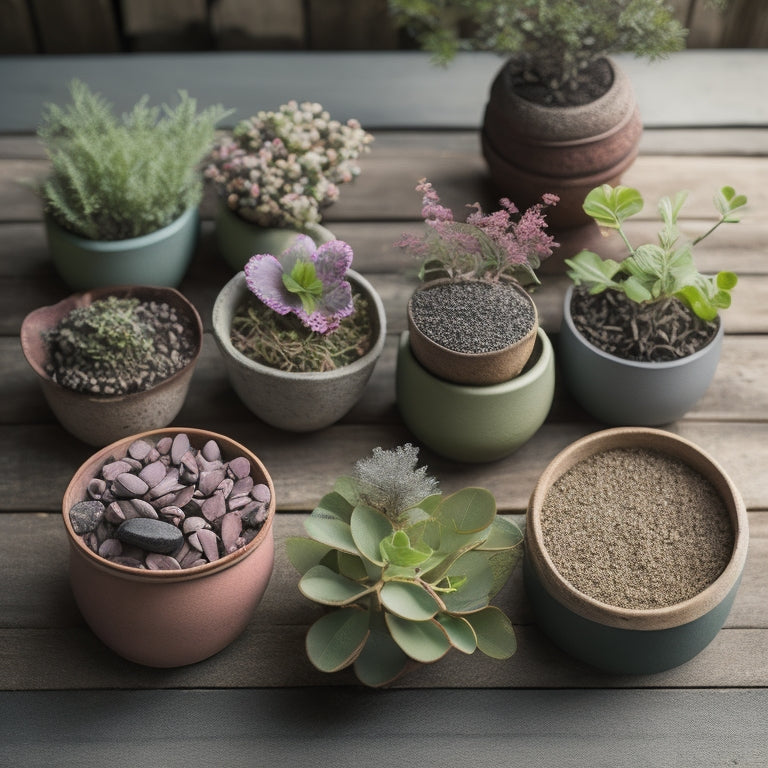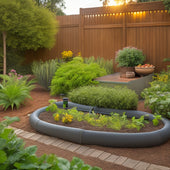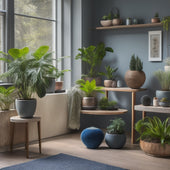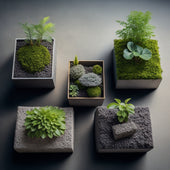
3 Best Planters for Small Herb Gardens Only
Share
You're looking for the perfect planter to bring your small herb garden to life, and with so many options available, it's important to choose one that fits your space, style, and herb-growing needs. For a rustic vibe, think about ceramic planters that offer durability and stylish appearance. If you prefer a more modern look, opt for metal or wooden trellises that provide a sleek vertical garden aesthetic. Finally, terracotta planters provide excellent drainage and breathability, making them ideal for moisture-loving herbs. As you narrow down your options, you'll discover even more factors to reflect on that'll help you grow a thriving herb garden.
Key Takeaways
• For small herb gardens, choose planters with good drainage solutions, such as built-in holes or aggregate addition, to prevent waterlogging.
• Select durable materials like ceramic, terracotta, or metal that can withstand outdoor weather conditions and support herb growth.
• Consider compact planter sizes ranging from 4-6 inches deep and 6-8 inches wide to fit small herbs and conserve space.
• Ceramic planters offer durability and style, while terracotta planters provide excellent drainage and breathability, ideal for moisture-loving herbs.
• Plastic planters are an affordable, low-maintenance option, offering lightweight and mobile choices for small herb gardens.
Cinder Block Planter Selection Criteria
When selecting a cinder block planter for your small herb garden, you'll want to contemplate several key factors to guarantee you choose the perfect one for your needs.
First, consider the cinder block aesthetics that fit your garden's style. Do you prefer a modern, industrial look or a more rustic, weathered appearance? The right aesthetic will enhance your garden's ambiance and create a cohesive atmosphere.
Next, think about drainage solutions. Cinder blocks can be prone to waterlogging, which can be detrimental to your herbs. Look for planters with built-in drainage holes or consider adding a layer of aggregate, like gravel or broken pottery, to facilitate water flow.
Additionally, consider the size and weight of the planter. Will it fit comfortably in your designated garden space, and can you easily move it if needed?
DIY Herb Garden Planter Ideas
With a little creativity and some basic materials, you can craft unique and functional DIY herb garden planters that showcase your personal style and complement your outdoor space.
Consider repurposing old pallets or crates to create a rustic vertical garden, perfect for maximizing space in small gardens. You can also upcycle old mason jars or tea cups to create charming hanging planters that add a touch of whimsy to your herb garden.
If you're looking for a more modern take, try using wooden or metal trellises to create a sleek and sophisticated vertical garden. You can also use a DIY planter box kit to create a customized planter that fits your specific needs.
Whichever route you choose, be certain to choose materials that are durable and weather-resistant to guarantee your herb garden thrives.
With a little bit of creativity and elbow grease, you can create a stunning DIY herb garden planter that reflects your personal style and adds beauty to your outdoor space.
Small Herb Garden Planters Compared
You'll find a wide range of small herb garden planters on the market, each varying regarding materials, design, and functionality, making it vital to compare their features and benefits to choose the one that best suits your needs.
When comparing planters, take into account the container sizes, which can range from small pots to larger planters. Some popular sizes include 4-6 inches deep and 6-8 inches wide, perfect for a few herbs, while larger planters can hold multiple herbs and provide more flexibility.
Material options are another important factor to take into account. You can choose from ceramic, terracotta, wood, metal, or plastic planters, each with its pros and cons. For instance, ceramic planters are durable and stylish, while terracotta planters provide good drainage and breathability.
Wooden planters add a natural touch, whereas metal planters are often lightweight and easy to move. Plastic planters are affordable and low-maintenance.
Frequently Asked Questions
Can I Grow Herbs Indoors Year-Round With Small Planters?
You can absolutely grow herbs indoors year-round with the right conditions. Indoor herb gardening allows you to control temperature, humidity, and light, ensuring ideal growth.
With a little planning, you'll enjoy fresh herbs 365 days a year. Choose a spot with bright, indirect light, and maintain temperatures between 65-75°F.
Water wisely, and fertilize regularly. By following these guidelines, you'll be harvesting fresh herbs in no time, regardless of the season.
How Often Should I Water My Small Herb Garden?
Are you wondering when to water your small herb garden? You're in control!
Check the soil moisture daily, and water only when it feels dry to the touch. You don't want to drown those delicate roots.
Watering frequency depends on the climate, pot size, and herb type. As a general rule, water every 2-3 days in summer and every 4-5 days in winter.
Do Small Herb Gardens Attract Pests or Rodents?
You're right to wonder if your small herb garden will attract unwanted visitors.
Unfortunately, yes, they can attract pests and rodents, especially if you're growing fragrant herbs like basil and mint.
To keep them at bay, focus on pest prevention and rodent control.
Use physical barriers, like copper mesh, to deter slugs and snails.
Keep your garden clean, removing weeds and debris that can harbor pests.
Regularly inspect your plants for signs of infestation and take action quickly if you spot any issues.
Can I Use Small Planters for Other Types of Plants Too?
Imagine a vibrant mini oasis on your balcony or patio, teeming with life and color.
You're not limited to herbs! You can use small planters to grow a variety of plants, depending on your plant selection.
Consider the planter materials, like ceramic or terracotta, that'll complement your chosen plants.
Succulents, strawberries, or flowers - the options are endless!
Just be sure to choose plants that thrive in small spaces and don't outgrow their containers.
Are Small Herb Gardens Difficult to Maintain and Care For?
You might wonder if small herb gardens are high-maintenance, but they're actually quite the opposite.
With a small herb garden, you'll enjoy the benefits of easier maintenance, as there's less soil to water and fewer weeds to combat.
Herb garden maintenance is a breeze, and the payoff is fresh, fragrant herbs right at your fingertips.
Plus, the compact size means you can tuck your garden into a tiny corner, making the most of your space.
Conclusion
You've narrowed down your options to the perfect planters for your small herb garden.
Now, it's time to get planting!
But before you do, take a step back and think: are you really making the most of your tiny space?
With the right planter, you can maximize your yield and add some serious style to your kitchen.
Which one will you choose?
Related Posts
-

Irrigation Solutions for Raised Bed Planters Made Easy
You can optimize your raised bed planters' irrigation system by understanding the complex interplay between soil type...
-

Irrigation Solutions for Raised Bed Planters Made Easy
You can optimize your raised bed planters' irrigation system by understanding the complex interplay between soil type...
-

Irrigation Solutions for Raised Bed Planters Made Easy
You can optimize your raised bed planters' irrigation system by understanding the complex interplay between soil type...
-

Irrigation Solutions for Raised Bed Planters Made Easy
You can optimize your raised bed planters' irrigation system by understanding the complex interplay between soil type...
-

Irrigation Solutions for Raised Bed Planters Made Easy
You can optimize your raised bed planters' irrigation system by understanding the complex interplay between soil type...
-

Irrigation Solutions for Raised Bed Planters Made Easy
You can optimize your raised bed planters' irrigation system by understanding the complex interplay between soil type...
-

Irrigation Solutions for Raised Bed Planters Made Easy
You can optimize your raised bed planters' irrigation system by understanding the complex interplay between soil type...
-

Irrigation Solutions for Raised Bed Planters Made Easy
You can optimize your raised bed planters' irrigation system by understanding the complex interplay between soil type...
-

Irrigation Solutions for Raised Bed Planters Made Easy
You can optimize your raised bed planters' irrigation system by understanding the complex interplay between soil type...
-

Irrigation Solutions for Raised Bed Planters Made Easy
You can optimize your raised bed planters' irrigation system by understanding the complex interplay between soil type...
-

Irrigation Solutions for Raised Bed Planters Made Easy
You can optimize your raised bed planters' irrigation system by understanding the complex interplay between soil type...
-

Irrigation Solutions for Raised Bed Planters Made Easy
You can optimize your raised bed planters' irrigation system by understanding the complex interplay between soil type...
-

Irrigation Solutions for Raised Bed Planters Made Easy
You can optimize your raised bed planters' irrigation system by understanding the complex interplay between soil type...
-

Irrigation Solutions for Raised Bed Planters Made Easy
You can optimize your raised bed planters' irrigation system by understanding the complex interplay between soil type...
-

Irrigation Solutions for Raised Bed Planters Made Easy
You can optimize your raised bed planters' irrigation system by understanding the complex interplay between soil type...
-

Irrigation Solutions for Raised Bed Planters Made Easy
You can optimize your raised bed planters' irrigation system by understanding the complex interplay between soil type...
-

Irrigation Solutions for Raised Bed Planters Made Easy
You can optimize your raised bed planters' irrigation system by understanding the complex interplay between soil type...
-

Irrigation Solutions for Raised Bed Planters Made Easy
You can optimize your raised bed planters' irrigation system by understanding the complex interplay between soil type...
-

Irrigation Solutions for Raised Bed Planters Made Easy
You can optimize your raised bed planters' irrigation system by understanding the complex interplay between soil type...
-

Irrigation Solutions for Raised Bed Planters Made Easy
You can optimize your raised bed planters' irrigation system by understanding the complex interplay between soil type...
-

Irrigation Solutions for Raised Bed Planters Made Easy
You can optimize your raised bed planters' irrigation system by understanding the complex interplay between soil type...
-

Irrigation Solutions for Raised Bed Planters Made Easy
You can optimize your raised bed planters' irrigation system by understanding the complex interplay between soil type...
-

Irrigation Solutions for Raised Bed Planters Made Easy
You can optimize your raised bed planters' irrigation system by understanding the complex interplay between soil type...
-

Irrigation Solutions for Raised Bed Planters Made Easy
You can optimize your raised bed planters' irrigation system by understanding the complex interplay between soil type...
-

Irrigation Solutions for Raised Bed Planters Made Easy
You can optimize your raised bed planters' irrigation system by understanding the complex interplay between soil type...
-

Irrigation Solutions for Raised Bed Planters Made Easy
You can optimize your raised bed planters' irrigation system by understanding the complex interplay between soil type...
-

Irrigation Solutions for Raised Bed Planters Made Easy
You can optimize your raised bed planters' irrigation system by understanding the complex interplay between soil type...
-

Irrigation Solutions for Raised Bed Planters Made Easy
You can optimize your raised bed planters' irrigation system by understanding the complex interplay between soil type...
-

7 Best Concrete Planter Ideas for Indoor Gardens
You're looking for a stylish and low-maintenance way to bring some greenery into your home, and concrete planters off...
-

7 Best Concrete Planter Ideas for Indoor Gardens
You're looking for a stylish and low-maintenance way to bring some greenery into your home, and concrete planters off...
-

7 Best Concrete Planter Ideas for Indoor Gardens
You're looking for a stylish and low-maintenance way to bring some greenery into your home, and concrete planters off...
-

7 Best Concrete Planter Ideas for Indoor Gardens
You're looking for a stylish and low-maintenance way to bring some greenery into your home, and concrete planters off...
-

7 Best Concrete Planter Ideas for Indoor Gardens
You're looking for a stylish and low-maintenance way to bring some greenery into your home, and concrete planters off...
-

7 Best Concrete Planter Ideas for Indoor Gardens
You're looking for a stylish and low-maintenance way to bring some greenery into your home, and concrete planters off...
-

7 Best Concrete Planter Ideas for Indoor Gardens
You're looking for a stylish and low-maintenance way to bring some greenery into your home, and concrete planters off...
-

7 Best Concrete Planter Ideas for Indoor Gardens
You're looking for a stylish and low-maintenance way to bring some greenery into your home, and concrete planters off...
-

7 Best Concrete Planter Ideas for Indoor Gardens
You're looking for a stylish and low-maintenance way to bring some greenery into your home, and concrete planters off...
-

7 Best Concrete Planter Ideas for Indoor Gardens
You're looking for a stylish and low-maintenance way to bring some greenery into your home, and concrete planters off...
-

7 Best Concrete Planter Ideas for Indoor Gardens
You're looking for a stylish and low-maintenance way to bring some greenery into your home, and concrete planters off...
-

7 Best Concrete Planter Ideas for Indoor Gardens
You're looking for a stylish and low-maintenance way to bring some greenery into your home, and concrete planters off...
-

7 Best Concrete Planter Ideas for Indoor Gardens
You're looking for a stylish and low-maintenance way to bring some greenery into your home, and concrete planters off...
-

7 Best Concrete Planter Ideas for Indoor Gardens
You're looking for a stylish and low-maintenance way to bring some greenery into your home, and concrete planters off...
-

7 Best Concrete Planter Ideas for Indoor Gardens
You're looking for a stylish and low-maintenance way to bring some greenery into your home, and concrete planters off...
-

7 Best Concrete Planter Ideas for Indoor Gardens
You're looking for a stylish and low-maintenance way to bring some greenery into your home, and concrete planters off...
-

7 Best Concrete Planter Ideas for Indoor Gardens
You're looking for a stylish and low-maintenance way to bring some greenery into your home, and concrete planters off...
-

7 Best Concrete Planter Ideas for Indoor Gardens
You're looking for a stylish and low-maintenance way to bring some greenery into your home, and concrete planters off...
-

7 Best Concrete Planter Ideas for Indoor Gardens
You're looking for a stylish and low-maintenance way to bring some greenery into your home, and concrete planters off...
-

7 Best Concrete Planter Ideas for Indoor Gardens
You're looking for a stylish and low-maintenance way to bring some greenery into your home, and concrete planters off...
-

7 Best Concrete Planter Ideas for Indoor Gardens
You're looking for a stylish and low-maintenance way to bring some greenery into your home, and concrete planters off...
-

7 Best Concrete Planter Ideas for Indoor Gardens
You're looking for a stylish and low-maintenance way to bring some greenery into your home, and concrete planters off...
-

7 Best Concrete Planter Ideas for Indoor Gardens
You're looking for a stylish and low-maintenance way to bring some greenery into your home, and concrete planters off...
-

Why Choose the Right Blocks for Your Planters
When creating a thriving planter, you need to choose the right blocks to support the entire ecosystem. Start by evalu...
-

Why Choose the Right Blocks for Your Planters
When creating a thriving planter, you need to choose the right blocks to support the entire ecosystem. Start by evalu...
-

Why Choose the Right Blocks for Your Planters
When creating a thriving planter, you need to choose the right blocks to support the entire ecosystem. Start by evalu...
-

Why Choose the Right Blocks for Your Planters
When creating a thriving planter, you need to choose the right blocks to support the entire ecosystem. Start by evalu...
-

Why Choose the Right Blocks for Your Planters
When creating a thriving planter, you need to choose the right blocks to support the entire ecosystem. Start by evalu...
-

Why Choose the Right Blocks for Your Planters
When creating a thriving planter, you need to choose the right blocks to support the entire ecosystem. Start by evalu...
-

Why Choose the Right Blocks for Your Planters
When creating a thriving planter, you need to choose the right blocks to support the entire ecosystem. Start by evalu...
-

Why Choose the Right Blocks for Your Planters
When creating a thriving planter, you need to choose the right blocks to support the entire ecosystem. Start by evalu...
-

Why Choose the Right Blocks for Your Planters
When creating a thriving planter, you need to choose the right blocks to support the entire ecosystem. Start by evalu...
-

Why Choose the Right Blocks for Your Planters
When creating a thriving planter, you need to choose the right blocks to support the entire ecosystem. Start by evalu...
-

Why Choose the Right Blocks for Your Planters
When creating a thriving planter, you need to choose the right blocks to support the entire ecosystem. Start by evalu...
-

Why Choose the Right Blocks for Your Planters
When creating a thriving planter, you need to choose the right blocks to support the entire ecosystem. Start by evalu...
-

Why Choose the Right Blocks for Your Planters
When creating a thriving planter, you need to choose the right blocks to support the entire ecosystem. Start by evalu...
-

Why Choose the Right Blocks for Your Planters
When creating a thriving planter, you need to choose the right blocks to support the entire ecosystem. Start by evalu...
-

Why Choose the Right Blocks for Your Planters
When creating a thriving planter, you need to choose the right blocks to support the entire ecosystem. Start by evalu...
-

Why Choose the Right Blocks for Your Planters
When creating a thriving planter, you need to choose the right blocks to support the entire ecosystem. Start by evalu...
-

Why Choose the Right Blocks for Your Planters
When creating a thriving planter, you need to choose the right blocks to support the entire ecosystem. Start by evalu...
-

Why Choose the Right Blocks for Your Planters
When creating a thriving planter, you need to choose the right blocks to support the entire ecosystem. Start by evalu...
-

Why Choose the Right Blocks for Your Planters
When creating a thriving planter, you need to choose the right blocks to support the entire ecosystem. Start by evalu...
-

Why Choose the Right Blocks for Your Planters
When creating a thriving planter, you need to choose the right blocks to support the entire ecosystem. Start by evalu...
-

Why Choose the Right Blocks for Your Planters
When creating a thriving planter, you need to choose the right blocks to support the entire ecosystem. Start by evalu...
-

Why Choose the Right Blocks for Your Planters
When creating a thriving planter, you need to choose the right blocks to support the entire ecosystem. Start by evalu...
-

Why Choose the Right Blocks for Your Planters
When creating a thriving planter, you need to choose the right blocks to support the entire ecosystem. Start by evalu...


